Contents
- Physical Features
- Climate
- Geology
- Soil
- Minerals
- Rivers
- Botany
- Wild Animals
- Birds
- Forest Reserves
- Nagzira Wildlife Sanctuary
- Navegaon National Park
- Nawegaon-Nagzira Tiger Reserve
- Land Use
- Environmental Concerns
- Waste Management
- Mining Activities
- Climate Change Vulnerability
- Industrial Pollution
- Conservation Efforts/Protests
- JNIL Protests
- Zudpi Jungle
- Sustainable Practices by the villagers
- Environmental NGOs
- SEWA
- Graphs
- Water
- A. Rainfall (Yearly)
- B. Rainfall (Monthly)
- C. No. of Rainy Days in the Year (Taluka-wise)
- D. Evapotranspiration Potential vs Actual Numbers (Yearly)
- E. Annual Runoff
- F. Runoff (Monthly)
- G. Water Deficit (Yearly)
- H. Water Deficit (Monthly)
- I. Soil Moisture (Yearly)
- J. Seasonal Groundwater Levels: Bore Wells
- K. Seasonal Groundwater Levels: Dug Wells
- Climate & Atmosphere
- A. Maximum Temperature (Yearly)
- B. Maximum Temperature (Monthly)
- C. Minimum Temperature (Yearly)
- D. Minimum Temperature (Monthly)
- E. Wind Speed (Yearly)
- F. Wind Speed (Monthly)
- G. Relative Humidity
- Forests & Ecology
- A. Forest Area
- B. Forest Area (Filter by Density)
- C. Wildlife Projects (Area and Expenses)
- Human Footprint
- A. Nighttime Lights
- Sources
GONDIA
Environment
Last updated on 6 November 2025. Help us improve the information on this page by clicking on suggest edits or writing to us.
Gondia district, located in the eastern part of Maharashtra, serves as a vital transitional zone between Maharashtra and Chhattisgarh, sharing borders with Madhya Pradesh to the north and Bhandara and Gadchiroli districts to the west and south. Spanning diverse landscapes from dense highland forests to fertile river valleys, the district exhibits distinct topographical features that shape its climate, agriculture, and natural resources. Dominated by the Wainganga River and its tributaries, Gondia benefits from rich alluvial deposits that support intensive farming. The region’s geological diversity, comprising Deccan Trap basalts, metamorphic formations, and alluvial plains, influences soil fertility, groundwater availability, and mineral wealth, including coal, manganese, and iron ore. With a tropical climate marked by hot summers, monsoonal rains, and cool winters, Gondia’s ecological and economic dynamics are closely tied to its natural environment, making it a significant contributor to the state’s agricultural and mineral industries.
Physical Features
Gondia district occupies the eastern portion of Maharashtra, positioned between 20°39' to 21°38' N latitude and 79°27' to 80°42' E longitude. The district shares boundaries with Madhya Pradesh in the north, Chhattisgarh in the east, Bhandara district in the west, and Gadchiroli district in the south. Its strategic location makes it an important transitional zone between Maharashtra and Chhattisgarh states.
The district's topography is characterized by three distinct physiographic zones spread across an elevation range of 300-900 meters above sea level. The highland zone, comprising 25% of the total area, features dense forests and serves as a crucial catchment area. This zone contains the southern extensions of the Satpuda Range and is composed primarily of metamorphic rocks and volcanic formations.
The middle plateau zone occupies 35% of the district's area and consists of gently sloping terrain interspersed with flat-topped hills. This region is dominated by black cotton soil and supports a mixture of agricultural and forest land. The plateau zone acts as a transitional area between the highlands and the river valleys, featuring numerous seasonal streams and small water bodies. The river valley zone, encompassing 40% of the district, forms the most productive region of Gondia. The Wainganga River and its tributaries - Bagh, Chulband, and Sur - have created fertile valleys filled with alluvial deposits. These lowlands support intensive agriculture and contain the majority of the district's settlements. The drainage pattern is predominantly dendritic, with an average annual flow of 1,500 million cubic meters.
The district's land use reflects its physical diversity, with 45% under agriculture, 30% under forest cover, 15% occupied by urban and settled areas, and 10% comprising water bodies and other uses. The forest cover totals 1,95,856 hectares, distributed among dense (30%), moderate (45%), and open forest (25%). The soil composition varies across the terrain, with black cotton soil dominating at 45%, followed by red and yellow soil at 30%, alluvial soil at 15%, and mixed soil types at 10%.
Climate

Gondia experiences a tropical wet and dry climate characterized by three distinct seasons. The climate is significantly influenced by its geographical location and the district's varied topography. The region falls under the dry subtropical agro-climatic zone, with pronounced seasonal variations in temperature, rainfall, and humidity.
The summer season extends from March to June, with May being the hottest month. Daytime temperatures frequently rise to 45°C, while minimum temperatures remain around 25°C. The humidity levels during this period drop to 20-30%, and the region experiences hot, dry winds locally known as "loo." Heat waves are common during April and May, affecting both agricultural activities and daily life.
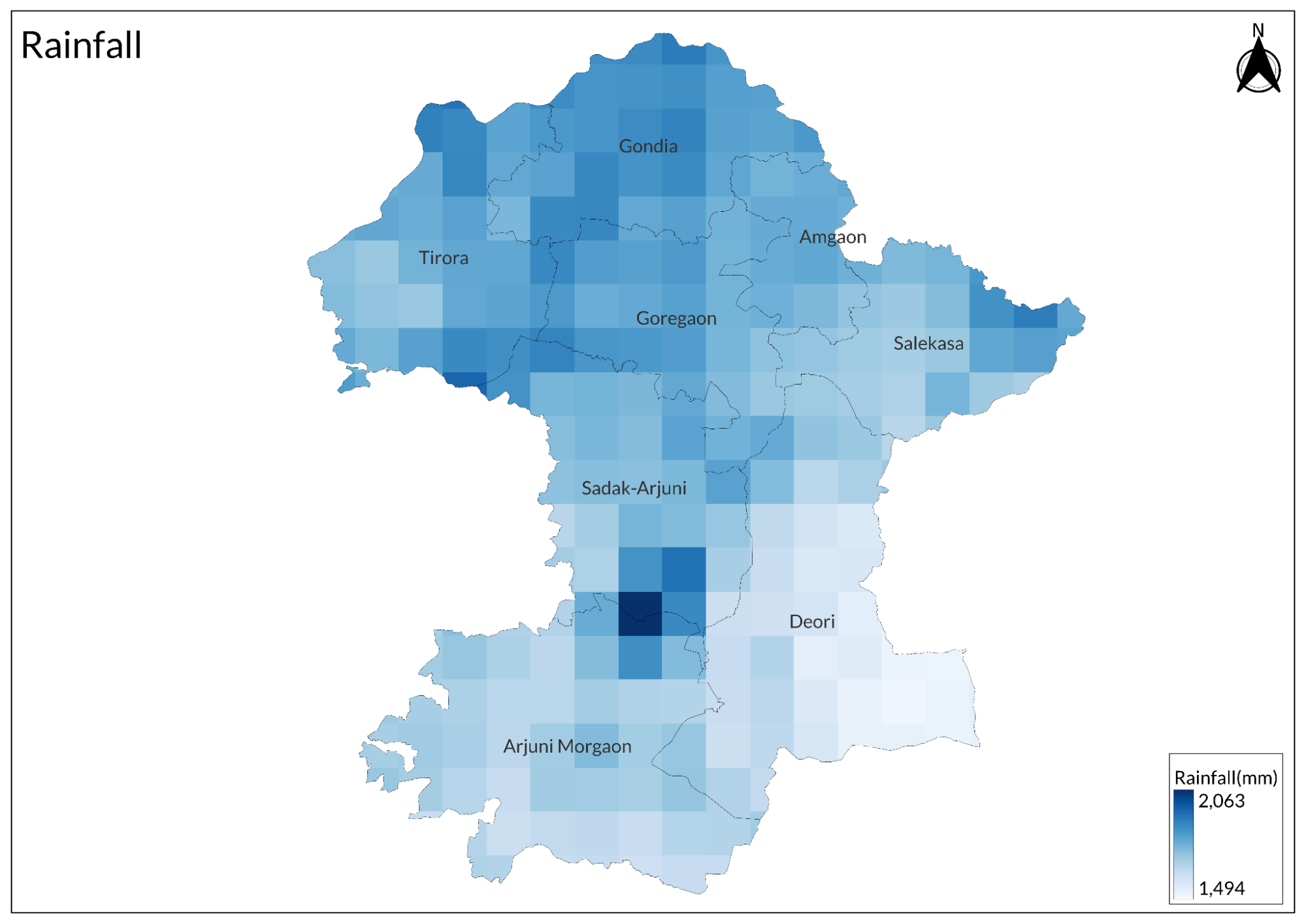
The monsoon season begins in late June and continues until September. The district receives an average annual rainfall of 1300-1400mm, with about 75% of precipitation occurring during July and August. The monsoon arrives from the southwest and is characterized by high humidity levels reaching 85-90%. The region experiences approximately 65-70 rainy days annually, with occasional heavy downpours leading to flash floods in low-lying areas. Winter extends from October to February, with December and January being the coldest months. The temperature ranges from 10°C to 25°C during this period. Morning fog is common in river valleys, particularly along the Wainganga River and its tributaries. The season experiences minimal rainfall, primarily from occasional western disturbances. Winter nights can be quite cold, with temperatures sometimes dropping below 10°C.
Microclimatic variations exist within the district due to its diverse topography. The highland areas experience slightly lower temperatures and higher rainfall compared to the valleys. The forest cover in the region plays a crucial role in moderating local climate conditions. The annual evaporation rate averages 1800mm, with maximum rates observed during the summer months.
Geology
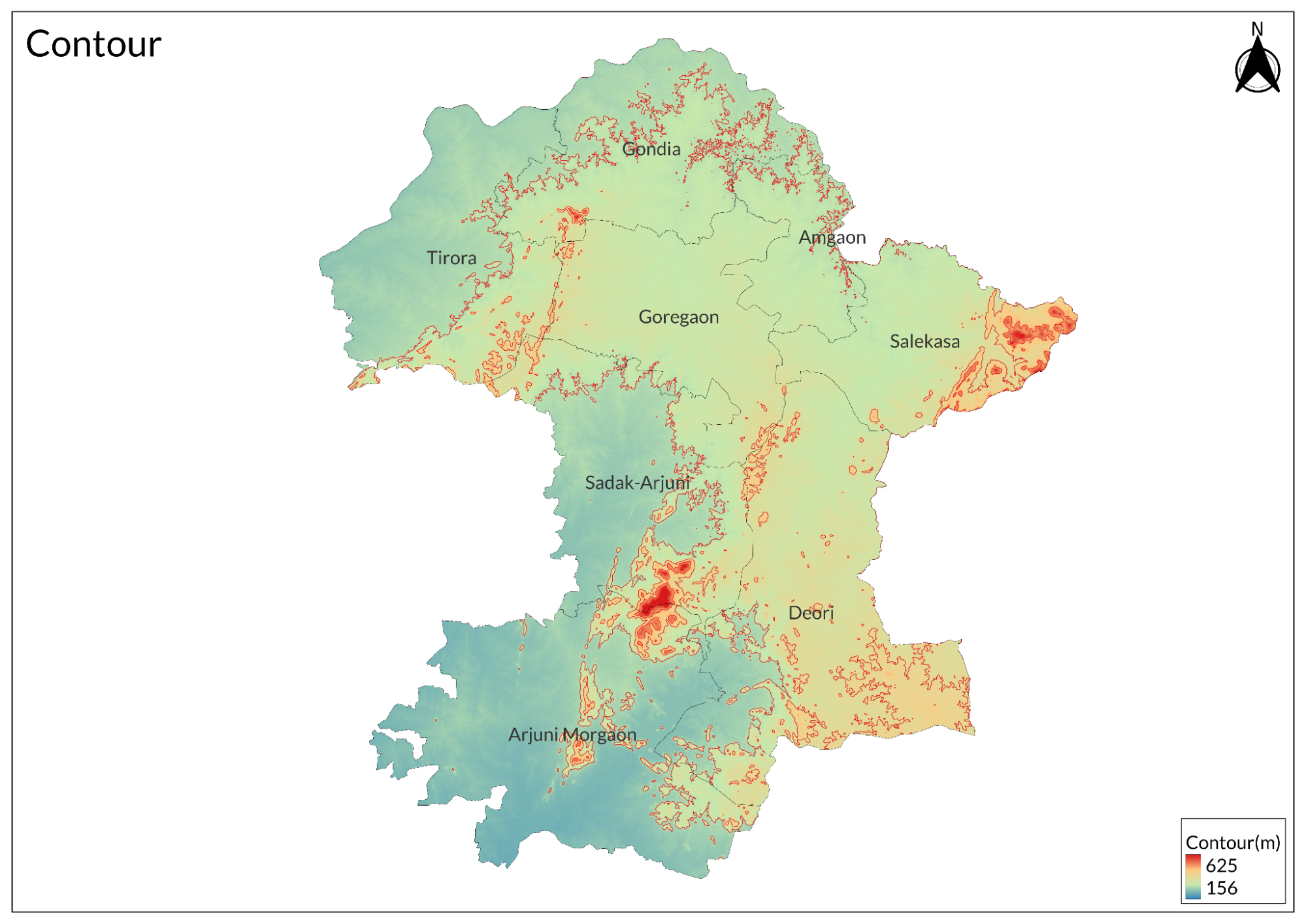
Gondia's geological foundation represents a complex assembly of rocks from various geological periods, primarily dominated by the Deccan Trap basalts formed during the Cretaceous-Eocene period. These volcanic formations resulted from extensive lava flows that covered most of central India, creating the characteristic stepped terrain visible across the district. The basaltic formations, which cover approximately 60% of the district area, show distinctive horizontal layering patterns resulting from successive lava flows.
The eastern and northeastern sections of the district feature significant exposures of metamorphic rocks dating back to the Precambrian age. These formations, occupying about 30% of the area, include gneisses, schists, and quartzites. The gneissic rocks display characteristic banding patterns and are frequently intruded by pegmatite veins, while the schists are predominantly composed of mica and hornblende varieties. Quartzite formations create resistant ridges and hills that form prominent features in the landscape.
The remaining 10% of Gondia's geology consists of more recent formations, including alluvial deposits and laterites. The alluvial deposits, concentrated along the Wainganga River and its tributaries, comprise layers of sand, silt, and clay from the Quaternary period. These deposits form crucial aquifers that support the region's groundwater resources. Lateritic formations appear as cappings on several plateaus, particularly in higher elevation areas.
The structural geology of the district is characterized by significant fault lines and fracture zones trending in NE-SW and NW-SE directions. These structural features have played a crucial role in shaping the region's drainage patterns and controlling the distribution of mineral deposits. The district contains valuable mineral resources, including coal deposits in the northern areas, manganese ore within the metamorphic terrain, and scattered iron ore occurrences. The basaltic rocks provide excellent building materials, while clay deposits support local brick-making industries.
Groundwater potential varies across the district according to the underlying geological formations. Alluvial areas show high groundwater potential, while weathered basalt zones offer moderate yields. The crystalline metamorphic rocks typically show lower groundwater potential, though fractured zones can form significant aquifers. This geological diversity has directly influenced soil formation patterns, land use capabilities, and the overall development of the region's natural resources.
Soil
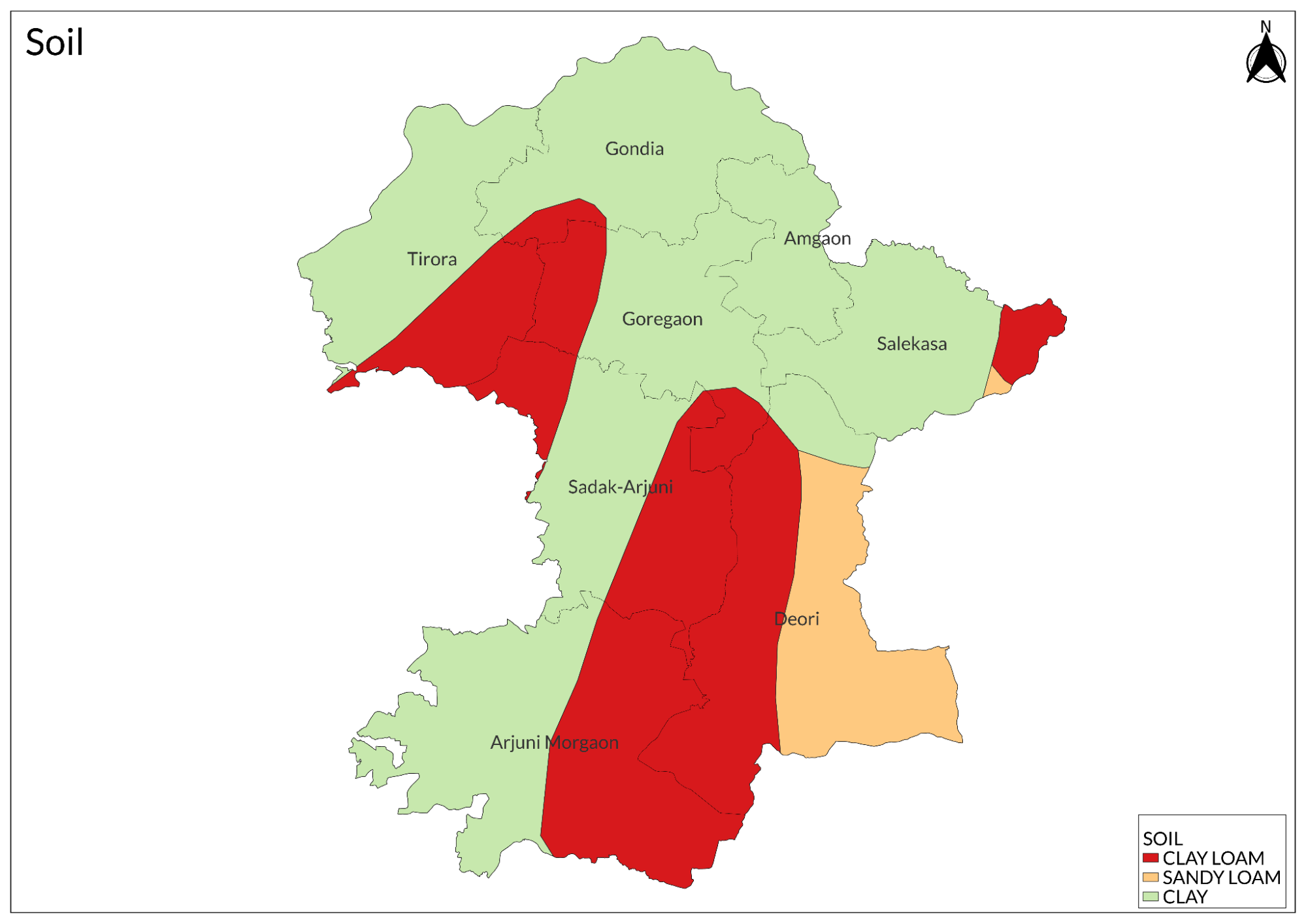
The most widespread soil type is black cotton soil, locally known as regur, which dominates the plains and valleys of the district. These soils are derived from the weathering of basaltic rocks and are characterized by their high clay content, excellent moisture retention capacity, and rich mineral composition. Black cotton soils are particularly suitable for growing cotton, jowar, wheat, and various pulses.
Red and yellow soils are predominantly found in areas where metamorphic rocks form the parent material, especially in the eastern parts of the district. These soils are well-drained and contain varying proportions of iron oxides, which give them their characteristic color. Though less fertile than black soils, they respond well to irrigation and fertilizers. These soils are particularly suitable for growing paddy, pulses, and oilseeds. The soil depth varies considerably, being shallow on uplands and deeper in valleys.
Alluvial soils occur along the Wainganga River and its tributaries, forming fertile stretches in the river valleys. These soils are composed of material transported and deposited by rivers, resulting in layers of sand, silt, and clay. They are generally fertile, well-drained, and rich in organic matter. Alluvial soils support intensive agriculture, particularly paddy cultivation, and are also suitable for growing vegetables and fruit crops. The texture of these soils varies from sandy loam to clay loam.
Mixed and lateritic soils are found in scattered patches throughout the district. Lateritic soils are primarily located in the higher elevation areas and are characterized by high iron and aluminum content, making them acidic. These soils have low fertility and require careful management for agricultural use. Mixed soils show characteristics intermediate between the major soil types, and their properties vary depending on local topography and parent material.
Minerals

Manganese ore constitutes another valuable mineral resource in the district. These deposits occur within the metamorphic terrain, particularly in areas where the bedrock consists of gondites and quartzites. The manganese ores are found in various grades, ranging from high-grade pyrolusite to lower-grade psilomelane and wad. The deposits are scattered throughout the metamorphic zones, with some significant concentrations in the eastern parts of the district.
Iron ore deposits, though limited in extent, are found in certain parts of the district. These deposits are typically associated with the older metamorphic rocks and occur as hematite and magnetite varieties. While not as extensive as the manganese deposits, they contribute to the district's mineral wealth and support small-scale mining operations.
Building materials form an important category of mineral resources in Gondia. The extensive basaltic formations provide excellent building stone, widely used in construction. Granite, found in some parts of the district, is quarried for ornamental and construction purposes. Clay deposits, particularly suitable for brick making, are abundant in the alluvial plains and are extensively utilized by the local construction industry.
Minor minerals and industrial minerals are also present in various locations throughout the district. These include dolomite, quartzite, and various types of construction aggregates. River sand deposits along the Wainganga and its tributaries form valuable resources for construction activities. The district also contains scattered occurrences of quartz and feldspar, which have industrial applications.
Rivers
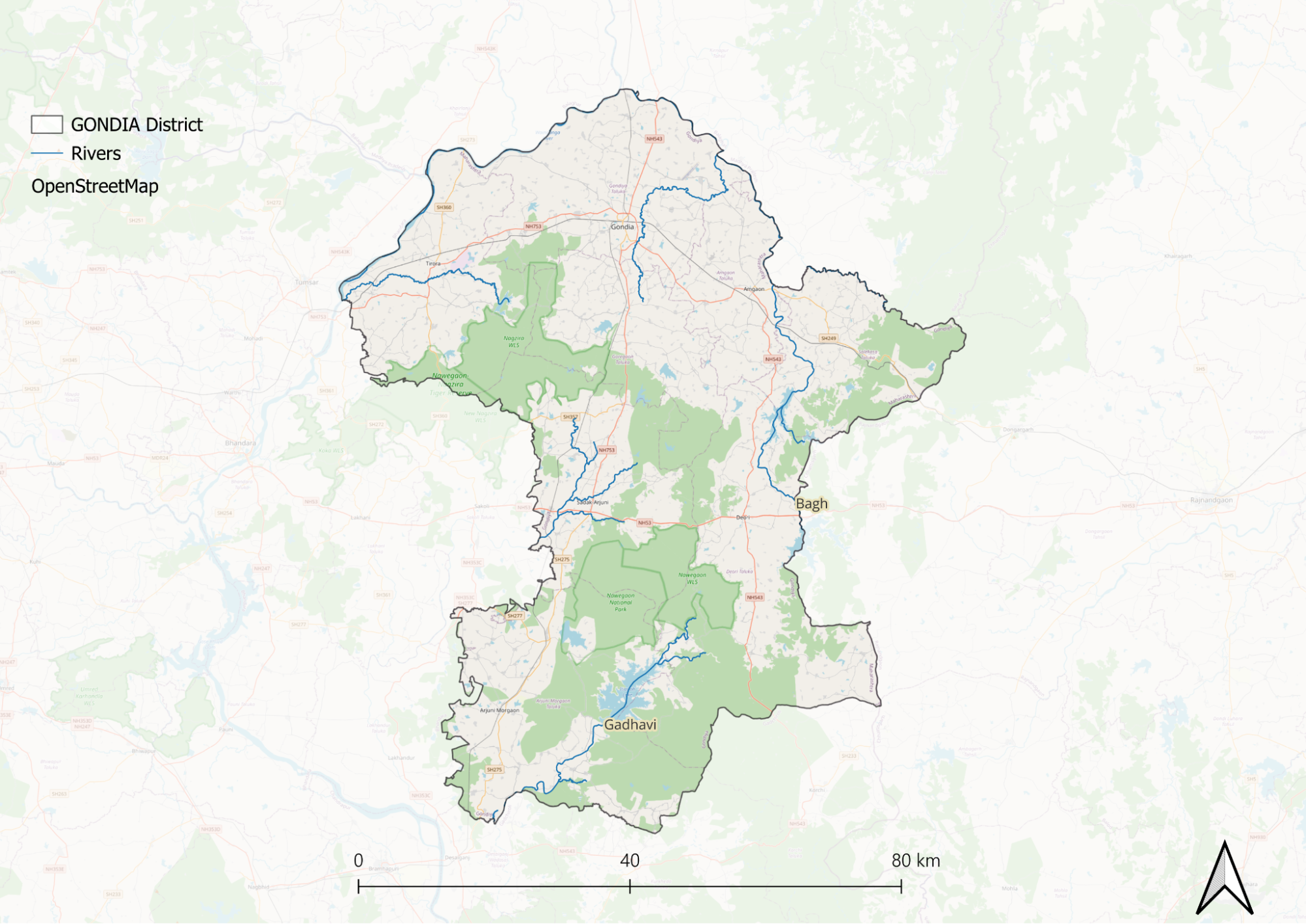

The Bagh River is a significant tributary of the Wainganga, flowing through the eastern parts of the district. It originates in the highlands and follows a meandering course before joining the Wainganga. The river's catchment area includes several forested regions, and its flow pattern is closely linked to the monsoon rainfall. The Bagh River valley supports extensive agricultural activities and serves as an important source of irrigation for the surrounding farmlands.

The Sur River contributes to the district's drainage network, flowing primarily through the southern regions. Like other rivers in the area, it shows marked seasonal variations in its flow. The Sur River's catchment area includes both forest and agricultural lands, making it an important source of water for local communities and wildlife.
Botany
The botanical profile of Gondia is characterized by Southern Tropical Dry Deciduous Forests, which form the dominant vegetation type across the district. These forests are primarily composed of Teak as the dominant species, interspersed with associated species like Ain, Dhawda, and Haldu. The forest canopy typically exhibits three distinct layers, with teak dominating the upper canopy, smaller trees forming the middle layer, and shrubs and herbs constituting the ground flora.
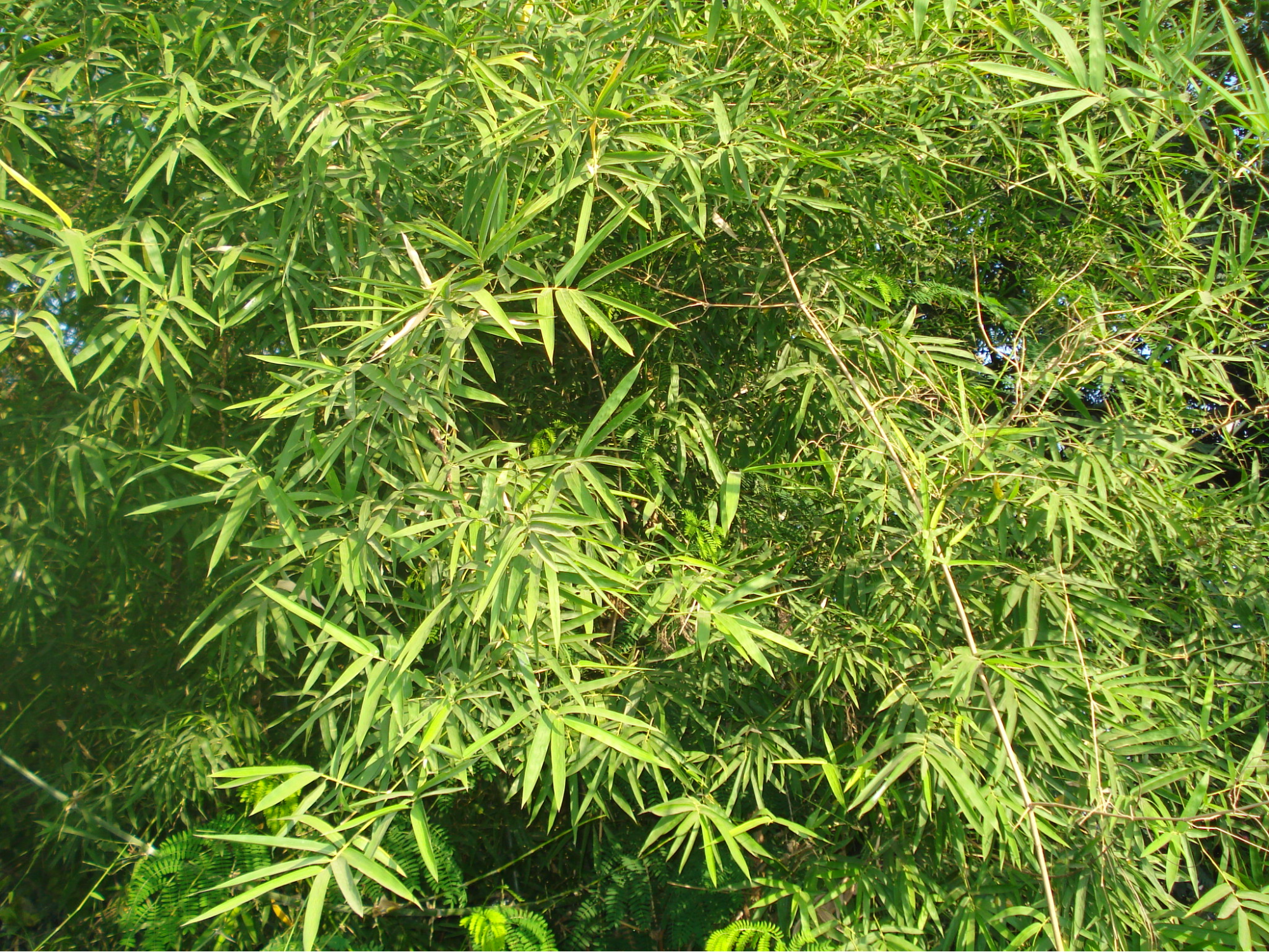
These bamboo brakes occur both as pure stands and as undergrowth in teak forests. Bamboo plays a crucial ecological role and supports various wildlife species while also providing economic benefits to local communities. Other bamboo species found in the region include Bambusa arundinacea and Dendrocalamus longispathus.
The district's grasslands and savanna woodlands occupy significant areas, particularly in the forest clearings and along river valleys. These areas support various grass species, including Sehima nervosum, Chrysopogon fulvus, and Heteropogon contortus. The grasslands are interspersed with scattered trees and shrubs, creating a mosaic pattern of vegetation that provides important habitats for wildlife.
Riparian vegetation along the Wainganga River and its tributaries forms distinct ecological communities. These areas support moisture-loving species such as Jamun, Arjun, and various species of ferns and reeds. The riverine forests play a crucial role in preventing soil erosion and maintaining water quality while providing corridors for wildlife movement.
Economically important tree species are well represented in the district, including Mahua, which is valuable for its flowers and seeds, Tendu for its leaves used in bidi making, and Char for its edible seeds. The district also harbors numerous medicinal plants such as Aonla, Baheda, and Nirgudi, which are traditionally used in local healthcare practices.
Wild Animals
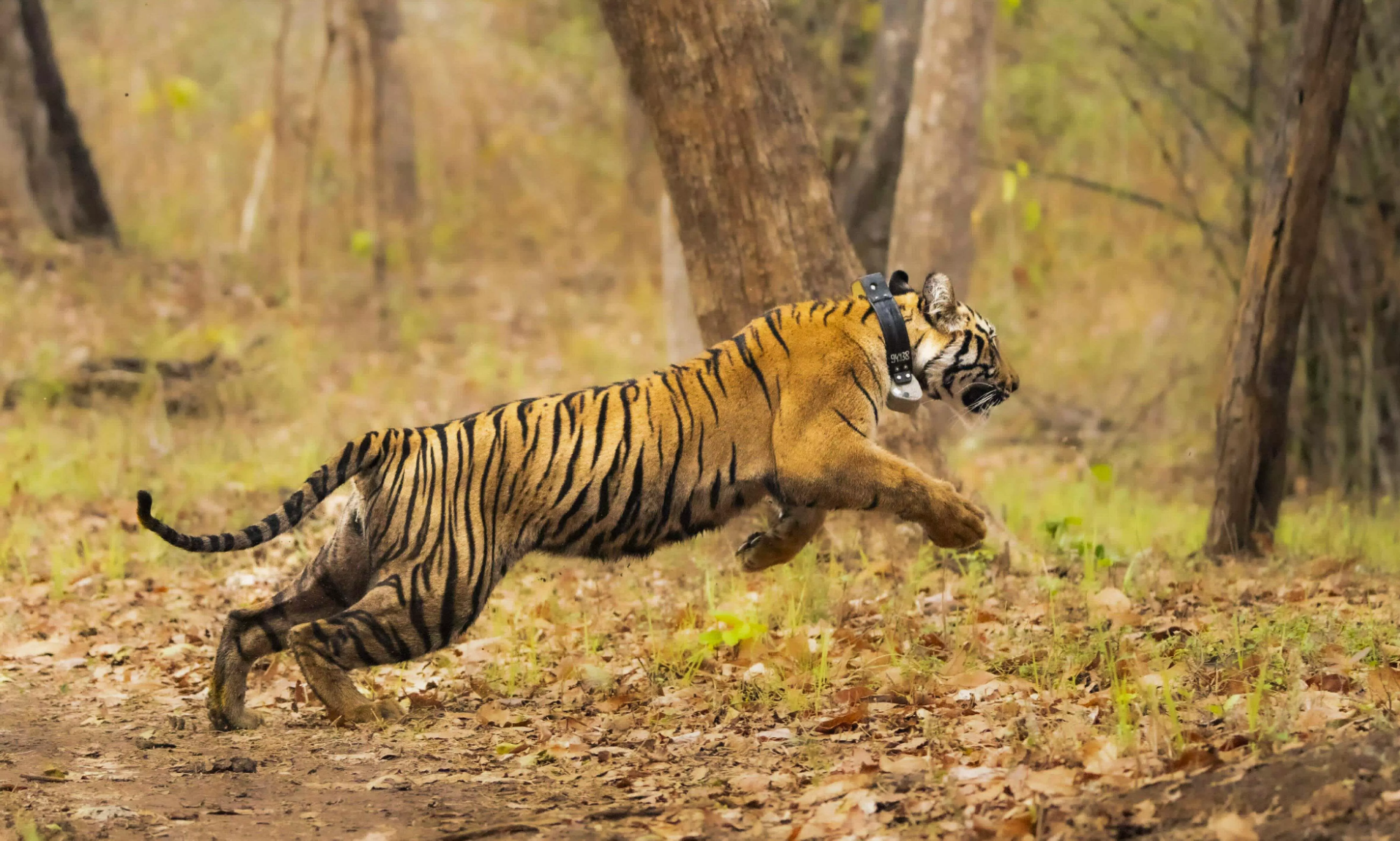
In addition to tigers, leopards are also common in Gondia, adapting well to various environments, including areas close to human settlements. These adaptable animals primarily hunt medium-sized mammals but may also prey on livestock. Other notable carnivores include the Indian Wild Dog (or Dhole), which hunts in packs, and the Sloth Bear, found in well-forested regions with rocky areas.
The herbivore population is diverse, featuring species like the Indian Gaur, which is the largest wild cattle species in the region. These animals thrive in hilly areas with abundant grass and bamboo. Other herbivores include Spotted Deer, Sambar, and Barking Deer, which serve as prey for the larger carnivores. Additionally, Wild Boars are plentiful throughout the forests and sometimes invade agricultural fields.
Gondia is also home to various small mammals such as the Indian Giant Squirrel, mongooses, and the Indian Pangolin. The forests support several primate species, including the Common Langur and Rhesus Macaque. The district's water bodies are crucial for semi-aquatic species like the Smooth-coated Otter, which inhabits rivers and their tributaries, along with Indian Monitor Lizards and various turtle species.
Birds
Over 166 bird species belonging to about 16 different orders and 47 families have been recorded in the area, particularly within the Nagzira Wildlife Sanctuary and Navegaon National Park. These habitats support a vibrant avifauna, including both resident and migratory birds.
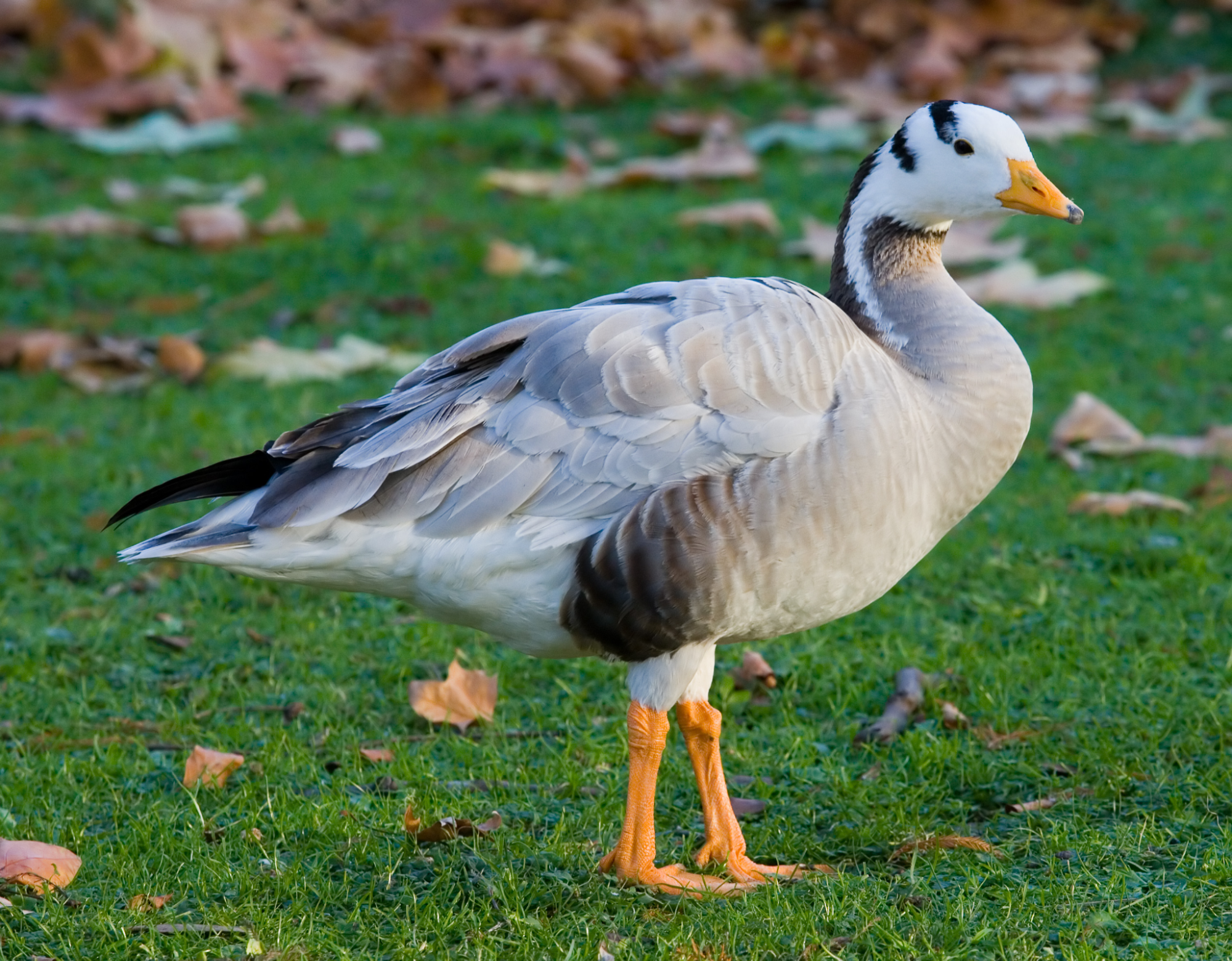
Additionally, approximately 42 species of local migrants contribute to the area's avian diversity, providing ample opportunities for bird enthusiasts to observe various species throughout the year.
Key locations for birdwatching in Gondia include the Nagzira Wildlife Sanctuary, known for its abundance of birds and diverse ecosystems. This sanctuary is a haven for both resident and migratory species. Similarly, Navegaon National Park is significant, hosting nearly 60% of the bird species found in Maharashtra. Other important sites include Bodalkasa Lake and Kawalewada Dam, where birdwatchers have recorded up to 69 species at Bodalkasa Lake and 76 species near Kawalewada Dam.
Forest Reserves
Nagzira Wildlife Sanctuary
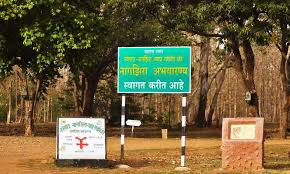
The sanctuary is known for its biodiversity, housing around 34 mammal species, 166 bird species, 36 reptile species, and four amphibian species. Notable wildlife includes the Bengal tiger, Indian leopard, gaur, and various species of deer and wild boar. The sanctuary is also recognized for its significant bird population, including migratory species like the Bar-headed Goose and endangered birds such as the Indian peafowl.
Navegaon National Park

It is home to about 26 mammal species, including tigers, panthers, and civets, along with 209 bird species and several reptiles. The park features Nawegaon Lake, which adds to its scenic beauty and ecological importance. Facilities for visitors include an interpretation center, museum, watchtowers, and cabins for wildlife observation.
Nawegaon-Nagzira Tiger Reserve
The Nawegaon-Nagzira Tiger Reserve (NNTR) was officially notified as the 46th tiger reserve in India on 12 December 2013. It encompasses the areas of Nawegaon National Park, Nagzira Wildlife Sanctuary, and other nearby protected areas. This reserve is critical for tiger conservation in central India, contributing significantly to the overall tiger population in the country.
Land Use
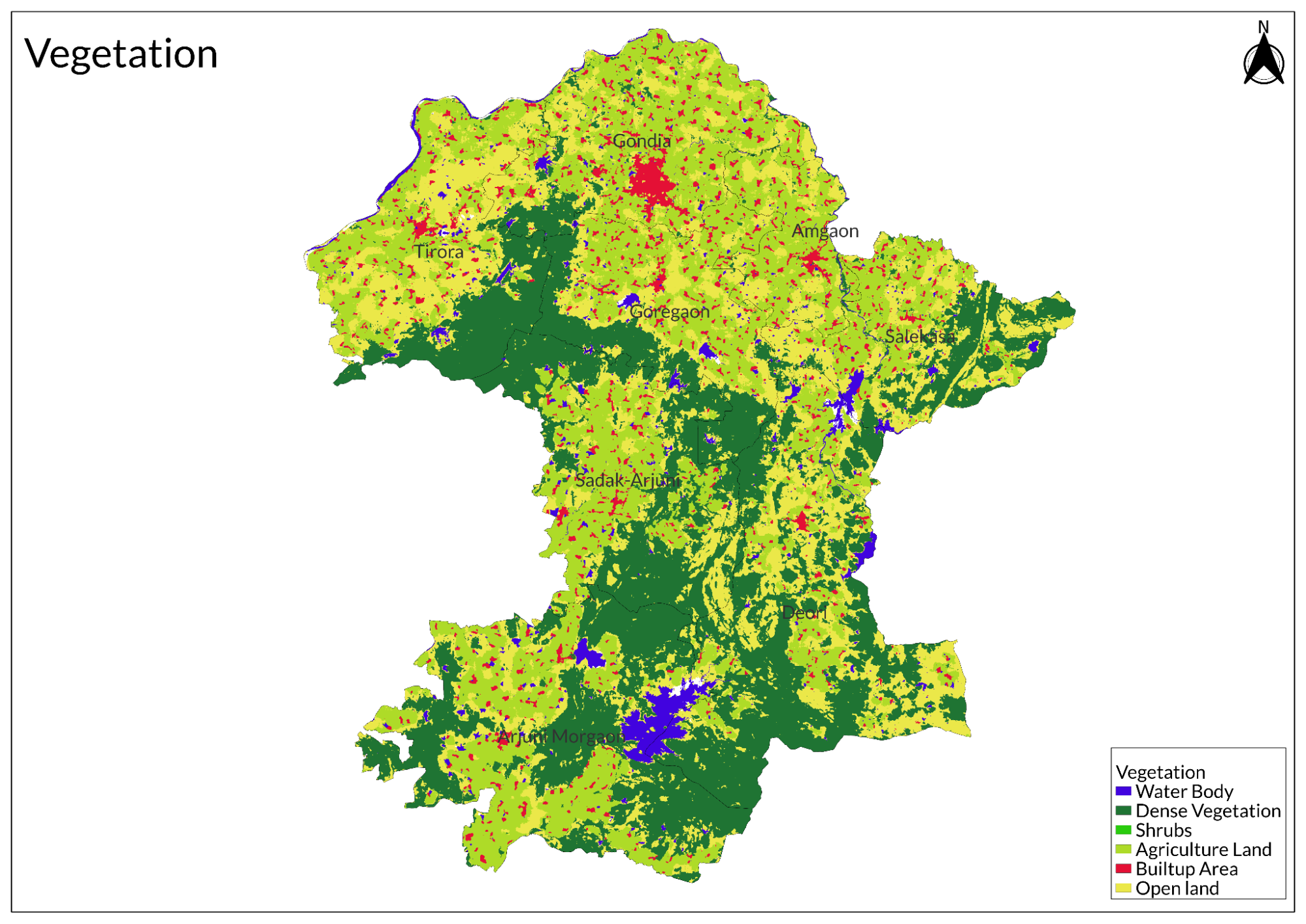
Environmental Concerns
Waste Management
Gondia district in Maharashtra faces significant waste management challenges, generating approximately 2.66 metric tons of construction and demolition waste and 1.79 metric tons of plastic waste daily, with organic waste forming the largest share due to its high organic carbon content. The Gondia Municipal Council oversees waste collection and disposal, operating a door-to-door plastic waste collection system, dedicated plastic waste centers, and authorized pickers to ensure proper waste management.
Mining Activities
Mining activities in the Gondia district, Maharashtra, cause severe environmental issues, including deforestation, water contamination, biodiversity loss, and carbon emissions. Open-pit mining leads to habitat destruction and disrupts ecological balance, endangering wildlife. Harmful chemicals from mine tailings, including arsenic, lead, and mercury, contaminate soil and water sources, posing risks to human health and aquatic life. Additionally, sand mining threatens riverine ecosystems, while carbon emissions from mining operations contribute to climate change, highlighting the urgent need for effective environmental management.
Climate Change Vulnerability
Gondia district in Maharashtra is increasingly vulnerable to the impacts of climate change, characterized by extreme temperature variations and unpredictable rainfall patterns. The region experiences very hot summers and cold winters, which can significantly affect local agriculture and livelihoods.
Most of Gondia's rainfall occurs during the southwest monsoon from June to September, with July and August being the peak months for precipitation. However, the district has faced recurrent droughts in recent years, notably in 2014, 2015, 2016, and 2018, which have severely impacted water availability and agricultural productivity. Conversely, flooding has also been a concern, with significant flood events recorded in 2016, 2019, and 2021.
Industrial Pollution
Industrial pollution in Gondia district, Maharashtra, is largely driven by over 50 parboiled rice mills, classified as the second most polluting industry by the CPCB. These mills contribute significantly to air and water pollution through untreated effluent discharge and improper disposal of boiler ash. Many Effluent Treatment Plants (ETPs) remain non-operational, allowing industrial waste to contaminate local water bodies and endanger public health. Additionally, rice husk ash is often dumped in open areas, further degrading the environment. Despite inquiries and warnings from the district collector, non-compliance with environmental regulations persists, with little improvement observed.
Conservation Efforts/Protests
JNIL Protests
In the Gondia district, villagers from Manegaon successfully halted tree felling initiated by the forest department for an iron ore mining project by Jayaswal Neco Industries Limited (JNIL), which received forest clearance for 17.56 hectares and planned to remove 3,141 large trees to mine 20,000 tons of iron ore annually. Local residents and green activists opposed the project due to their dependence on the forest, with the Manegaon gram panchayat passing a resolution against it in May 2022, citing the absence of a no-objection certificate (NOC). Upon discovering the tree cutting, villagers intervened and threatened a hunger strike. Activists raised ecological concerns, highlighting the presence of protected species like leopards and Indian wolves. Despite being 12 kilometers from the Navegaon-Nagzira Tiger Reserve, the site is a crucial wildlife habitat, and conservationists argue a thorough wildlife survey should have preceded project approval.
Zudpi Jungle
In Gondia district and Maharashtra's eastern Vidarbha region, tribal communities protested against the government's move to designate Zudpi Jungle lands as reserve forests, which are crucial for their grazing, agriculture, and cultural practices. The new designation restricted access, banning grazing and resource use without permits, leading to widespread unrest. In 2024, the government intensified efforts to finalize forest settlements, overlapping areas already recognized under the Forest Rights Act (FRA), effectively nullifying some tribal land ownership titles. Villagers in Gondia, Chandrapur, and Nagpur resisted these changes, fearing the loss of access to essential resources like grazing grounds and water bodies, accusing the government of FRA violations.
Sustainable Practices by the villagers
In Dhamditola village, residents have banned setting fires to the forest floor after tendu leaf and mahua flower collection seasons, implemented fire monitoring systems, and demarcated fire lines, significantly reducing forest fires amid rising global incidents due to climate change. Since the enactment of the FRA in 2006, over 6,500 villages in Gondia have benefited from community forest rights, empowering locals to combat illegal logging and improve both ecology and economic opportunities. Villagers like Dhansingh Janglu Dugga patrol forests to prevent timber theft, with fines for violations reinvested into community welfare. These efforts showcase how indigenous knowledge and local governance can effectively conserve and regenerate forests, ensuring sustainability for future generations.
Environmental NGOs
SEWA
Sustaining Environment and Wildlife Assemblage (SEWA), an NGO based in Gondia, Maharashtra, has been actively involved in wildlife conservation since its establishment in 2014. Situated near the borders of Madhya Pradesh and Chhattisgarh, SEWA focuses on protecting forests and wildlife, particularly around the Navegaon-Nagzira Tiger Reserve. The organization collaborates with local communities and forest officials to implement various initiatives aimed at reducing human-wildlife conflict, conducting anti-poaching drives, and raising awareness about conservation.
One of SEWA's key projects involves studying tiger dispersal patterns to enhance management practices for their long-term survival. The organization has identified critical corridors that tigers use to move between different habitats, emphasizing the importance of protecting these areas. SEWA also supports the Forest Department by establishing a reliable network of informers that has led to successful raids and arrests of poachers.
In addition to its focus on tigers, SEWA has made significant strides in protecting the Sarus Crane population in Gondia. Through community engagement and education, the organization has successfully increased the number of Sarus Cranes from just two individuals in 2003-04 to over 35 today. This success is attributed to initiatives such as nest protection and sensitizing farmers to coexist with these birds.
Graphs
Water
Climate & Atmosphere
Forests & Ecology
Human Footprint
Sources
About Nawegaon Nagzira Tiger Reserve. 2023. NNTR Official.https://www.nawegaonnagzira.com/
Behl, M. 2016, August 22. Rice mills at Gondia causing pollution. The Times of India.https://timesofindia.indiatimes.com/city/nag…
Boga, D. 2013, November 21. Mining poisons drinking water in Bhandara, Gondia: Study. DNA India.https://www.dnaindia.com/mumbai/report-minin…
Book Nagzira Jungle Safari. 2022. Nagzira Jungle Safari.https://www.nagzirajunglesafari.com/book_saf…
Katre, N. H., & Pandey, D. 2012.Municipal solid waste problem and management in Gondia city in indian perspective (Ms): A case study.https://www.semanticscholar.org/paper/MUNICI…
Lopes, F. 2022, April 3. Defenders Of The Forest: How Forest Dwelling-Communities Of Gondia Are Regenerating Forests. Vikalp Sangam.
Nagzira Wildlife Sanctuary. 2023. Tadoba National Park.https://www.tadobanationalpark.in/nagzira-wi…
Nagzira Wildlife Sanctuary. 2025. Directorate of Tourism, Department of Tourism, Government of Maharashtra.https://maharashtratourism.gov.in/wildlife/n…
Nagzira Wildlife Sanctuary. 2025. District Gondia, Government of Maharashtra.https://gondia.gov.in/en/tourist-place/nagzi…
Nagzira. 2025. InWikipedia.https://en.wikipedia.org/w/index.php?title=N…
Nair, A. 2017, February.Sustaining Environment And Wildlife Assemblage (SEWA). Sanctuary Nature Foundation; First published in Sanctuary Asia, 37(2), February 2017.https://www.sanctuarynaturefoundation.org/ar…
Singh, P. 2024. Nagzira National Park Safari Booking, Nagzira Wildlife Sanctuary. GTI Travels.https://www.nagzirawildlifesanctuary.com/
Last updated on 6 November 2025. Help us improve the information on this page by clicking on suggest edits or writing to us.